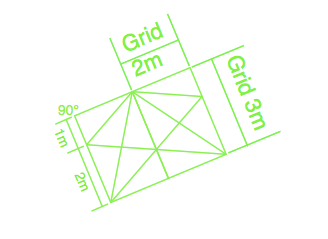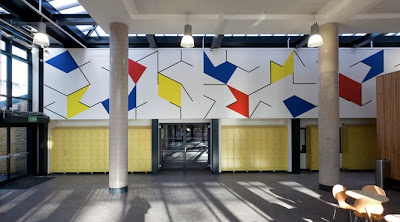Several years ago, I came across this photo on the Playscapes blog which blew my mind. It had so much to it, that I’m still trying to take stock of its potential, fun and relevance to schools everywhere. It is the work of Simon and Tom Bloor. It can be found at Cotham School in Bristol and is called ‘Formula for Living – Linear Composition’.

As you can see from the photo, this is not your average hopscotch or alphabet snake. The design is incredibly open-ended with all sorts of play and learning possibilities. Simon and Tom kindly shared the grid they used.

And how this was turned into the composition:

Now that you see how it was designed, infinite possibilities exist. This particular grid is extremely open-ended. If you look at colouring books of symmetrical patterns, or traditional patchwork quilt designs, then suddenly the principle can be widely applied.
In the words of Simon and Tom Bloor, there were lots of reasons for developing this particular design.
“We wanted to create an artwork with an opportunity for some form of potential use, but where a function is still to be realised and can change depending on the user’s needs and desires. In response to the school’s specialisms in Mathematics and Performing Arts we made an abstract design that might look like a lost mathematical language, architectural ground plan or futuristic playground game and that could encourage users to act in a playful way as they navigate the space. The work’s linear pattern creates corridors and enclosed zones, offering new ways to navigate the yard and small areas for individual and group activity.”
Simon and Tom have used this grid for other designs and projects too. For example, the chalkboards below have been created from the same grid. These can be found at Hermitage Primary in Tower Hamlets, London. Be warned – the more you look at these, the more possibilities that you see appearing…
When I ran primary outdoor maths courses I would often ask participants to come up with challenges and investigations based upon this free form geometry. Here’s some of the ideas:
- Which line will produce the most 4-side shapes?
- How many children can fit on one line?
- What is the total length of the red lines, blue lines and yellow lines? Does this match your estimates from before you undertook the measuring activity?
- Blindfold child and see if another child can give accurate directions to walk the line.
- What household or other objects do these lines remind you of?
- Which shapes are symmetrical and which could be made symmetrical with the addition of one more line or the use of complimentary coloured chalk?
- What shapes could be made from each starter using just one more line?
- Can we use sticks in some way to accurately recreate the shapes on a smaller scale?
- Create Carroll or Venn Diagrams to sort and classify the markings, e.g. Red – Not Red, Right Angle – Not Right Angle
- Find a path from one end of the playground to the other using alternate colours
- Play ‘Human Pinball’. Plot a path. Travel in straight lines and change direction when meeting another line. This could be tested with a football too.
One of the other things I love about this design is that you can take the idea and adapt it with your class. Rather than going down the route of thermoplastic markings which are expensive, why not brainstorm your own markings with your class, draw them outside to scale and then design challenges for other classes to complete. This is practical, collaborative, good value and a refreshing option especially for older children to come up with for working alongside younger ones. I’m sure many families would enjoy the experience too… !
As well as the “Formula for Living” linear playground design. Tom and Simon also created a spatial composition indoors. Again, this is a useful springboard into geometry-based artwork:

All-in-all, their design work demonstrates that simple playground markings can be remarkably effective as tools for play and learning encouraging higher order thinking on both accounts. Tom and Simon Bloor have continued to work on other school and public design projects encouraging children, staff and the public to consider the design potential of many objects and spaces in fresh ways. Their website shows examples of these, all of which are inspirational and great for further reflective thinking around art, design and maths outdoors.
This blog post was originally published in November 2012.




















Fantastic playground markings – these are what we need to see more of in schools up and down the country. Children need to be active & have fun, whilst staying intrigued…